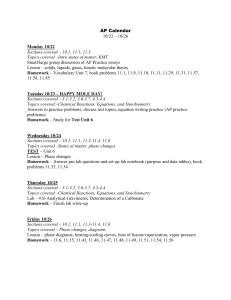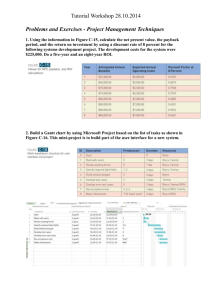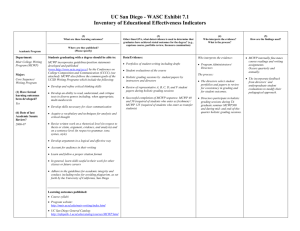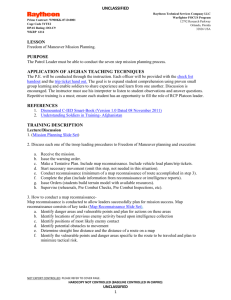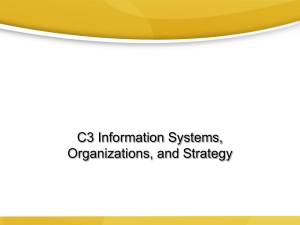C1 Change 1 Headquarters
advertisement
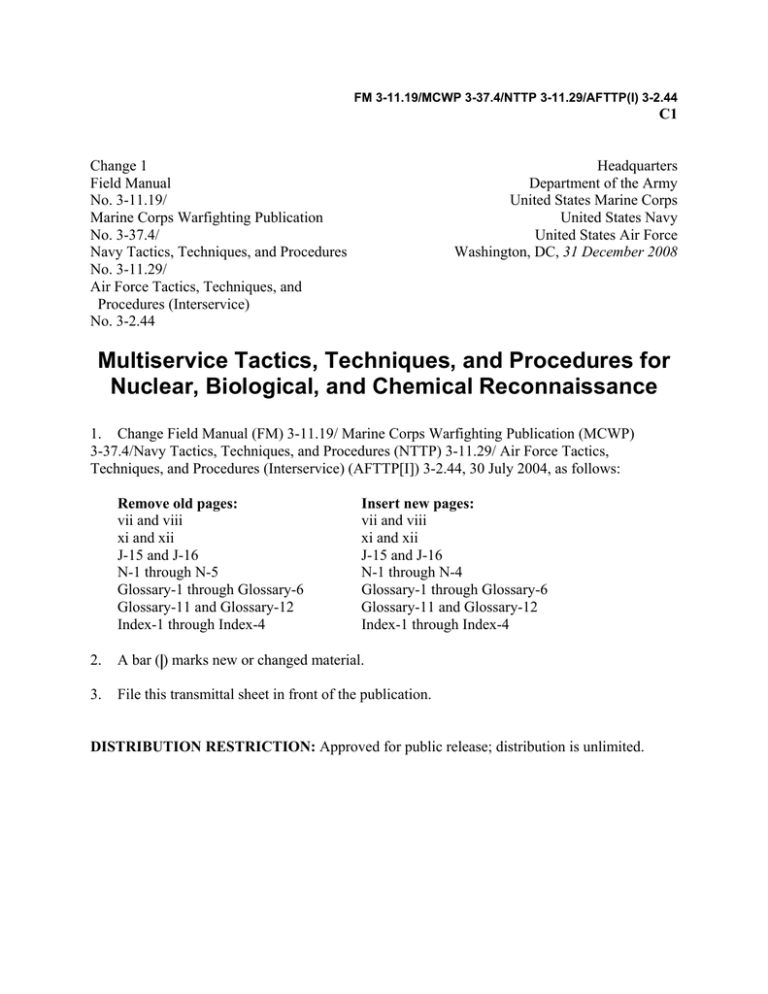
FM 3-11.19/MCWP 3-37.4/NTTP 3-11.29/AFTTP(I) 3-2.44 C1 Change 1 Field Manual No. 3-11.19/ Marine Corps Warfighting Publication No. 3-37.4/ Navy Tactics, Techniques, and Procedures No. 3-11.29/ Air Force Tactics, Techniques, and Procedures (Interservice) No. 3-2.44 Headquarters Department of the Army United States Marine Corps United States Navy United States Air Force Washington, DC, 31 December 2008 Multiservice Tactics, Techniques, and Procedures for Nuclear, Biological, and Chemical Reconnaissance 1. Change Field Manual (FM) 3-11.19/ Marine Corps Warfighting Publication (MCWP) 3-37.4/Navy Tactics, Techniques, and Procedures (NTTP) 3-11.29/ Air Force Tactics, Techniques, and Procedures (Interservice) (AFTTP[I]) 3-2.44, 30 July 2004, as follows: Remove old pages: vii and viii xi and xii J-15 and J-16 N-1 through N-5 Glossary-1 through Glossary-6 Glossary-11 and Glossary-12 Index-1 through Index-4 Insert new pages: vii and viii xi and xii J-15 and J-16 N-1 through N-4 Glossary-1 through Glossary-6 Glossary-11 and Glossary-12 Index-1 through Index-4 2. A bar (|) marks new or changed material. 3. File this transmittal sheet in front of the publication. DISTRIBUTION RESTRICTION: Approved for public release; distribution is unlimited. FM 3-11.19/MCWP 3-37.4/NTTP 3-11.29/AFTTP(I) 3-2.44 C1 31 December 2008 By Order of the Secretary of the Army: GEORGE W. CASEY, JR. General, United States Army Chief of Staff Official: JOYCE E. MORROW Administrative Assistant to the Secretary of the Army 0833702 DISTRIBUTION: Active Army, Army National Guard, and U.S. Army Reserve: To be distributed in accordance with the initial distribution number 115094, requirements for FM 3-11.19. By Order of the Secretary of the Air Force MAX E. KIRSCHBAUM Colonel, USAF Commander Headquarters, Air Force Civil Engineer Support Agency Air Force Distribution: F Marine Corps PCN: 143 000146 00 Page Transfer Operations .......................................................................................... E-45 Labeling and Documentation .......................................................................... E-50 Packaging of Samples for Shipment............................................................... E-52 Transfer of Samples to a Laboratory or Lead Agency ................................. E-58 APPENDIX F ORGANIZATIONS AND EQUIPMENT................................................................. F-1 Background ............................................................................................................ F-1 United States Army Capabilities ....................................................................... F-1 United States Marine Corps Capabilities ......................................................F-11 United States Air Force Capabilities...............................................................F-12 United States Navy Capabilities......................................................................F-14 Unit Level Chemical and Radiological Detection Equipment ....................F-20 Chemical Detector Capabilities and Interferents .........................................F-22 Special-Purpose Equipment..............................................................................F-26 APPENDIX G MOVEMENT FORMATIONS AND MOVEMENT, SURVEY, AND SEARCH TECHNIQUES ........................................................................................ G-1 Background ........................................................................................................... G-1 Movement Formations........................................................................................ G-1 Movement Techniques ........................................................................................ G-6 Survey Techniques .............................................................................................. G-7 Search Techniques.............................................................................................G-13 APPENDIX H SURVEILLANCE TECHNIQUES .......................................................................... H-1 Background ........................................................................................................... H-1 Establishing an Automatic Chemical-Agent Alarm Detector Network (Monitoring) .................................................................... H-1 Observing Specified Areas (Named Areas of Interest).................................. H-5 Conducting Standoff Chemical-Agent, Line-of-Sight Detection (Monitoring) ................................................................................... H-6 Establishing a Biological-Agent Detector Array (Monitoring)..................... H-6 Conducting Biological-Agent Surveillance (Standoff Detection) ................. H-8 Conducting Medical Surveillance ................................................................... H-10 APPENDIX I RADIOLOGICAL SEARCH AND SURVEY DETECTION METHODS ............ I-1 Background ............................................................................................................. I-1 Area Monitoring ..................................................................................................... I-1 Monitoring Techniques ......................................................................................... I-2 Correlation Factors ................................................................................................ I-3 Recording................................................................................................................. I-4 Radiological Surveys ............................................................................................. I-4 Radiological Monitoring (Search) ...................................................................... I-10 APPENDIX J UNITED STATES ARMY NUCLEAR, BIOLOGICAL, AND CHEMICAL RECONNAISSANCE UNIT OPERATIONS.................................... J-1 Background ............................................................................................................ J-1 Equipment ...................................................................................................................J-1 31 December 2008 FM 3-11.19/MCWP 3-37.4/NTTP 3-11.29/AFTTP(I) 3-2.44, C1 vii Page Functions and Responsibilities........................................................................... J-3 Types of Reconnaissance Units .......................................................................... J-4 Planning ............................................................................................................ J-7 Search and Survey ......................................................................................... J-10 Surveillance .........................................................................................................J-12 Sampling.......................................................................................................... J-15 Unit Employment ........................................................................................... J-16 APPENDIX K MONITORING, RECONNAISSANCE, SURVEILLANCE, AND SURVEY REPORTS ......................................................................................K-1 Background ...................................................................................................................K-1 Types of Reports ......................................................................................................K-1 Integrated, Automated Warning and Reporting ..............................................K-7 Reporting........................................................................................................................K-7 APPENDIX L CHEMICAL SERVICES ORGANIZATIONS........................................................ L-1 Background ............................................................................................................ L-1 General ........................................................................................................................... L-1 Support to Special Operations Principal Missions ......................................... L-2 Support to Special Operations Collateral Missions ........................................ L-3 Five-Man LB Team ..............................................................................................L-4 Special Forces Chemical Reconnaissance Detachment ................................. L-7 Communications ................................................................................................... L-9 Command and Staff Relationships ...................................................................... L-9 Premission Activities................................................................................................L-1 0 Mission Activities ......................................................................................................L-1 3 Postmission Activities .............................................................................................. L-1 6 APPENDIX M ADVANCED STANDOFF CHEMICAL DETECTOR ................................. M-1 Background .......................................................................................................... M-1 Concept of Operations.......................................................................................................... M-3 Air Base Fixed-Site Employment ............................................................................ M-8 Aerospace Configuration ............................................................................................ M-10 Maritime Configuration .............................................................................................. M-10 APPENDIX N MOUNTED CHEMICAL, BIOLOGICAL, RADIOLOGICAL, AND NUCLEAR RECONNAISSANCE OPERATIONS......................................... N-1 Background ...................................................................................................................N-1 Capabilities....................................................................................................................N-1 Planning Considerations ...........................................................................................N-2 Employment Considerations....................................................................................................N-2 REFERENCES ...................................................................................................References-1 GLOSSARY ...........................................................................................................Glossary-1 INDEX ...........................................................................................................................Index-1 viii FM 3-11.19/MCWP 3-37.4/NTTP 3-11.29/AFTTP(I) 3-2.44, C1 31 December 2008 Page Figure G-19. Multiple Sweeps Using the Zigzag Search Technique...............................................................................................................G-14 Figure G-20. Lane Search Technique ................................................. G-15 Figure G-21. Cloverleaf Search Technique ....................................... G-16 Figure H-1. Dice Five Pattern Detector Placement ...........................H-2 Figure H-2. Fixed Emplacement of ACAAs ...........................................H-3 Figure I-1. Sample Survey Data (Monitoring or Point Technique) ........................................................................................... I-8 Figure I-2. Sample Survey Data (Route or Course Leg Technique) ........................................................................................... I-9 Figure I-3. Sample Mission Order Format ......................................... I-11 Figure K-1. Sample NBC 3 Report (Nuclear) .......................................K-2 Figure K-2. Sample NBC 3 Report (CB) ................................................K-3 Figure K-3. Sample NBC 3 Report (Release-OtherThan-Attack) .......................................................................................K-4 Figure K-4. Sample NBC 4 Report (CB or Release-OtherThan-Attack) .......................................................................................K-5 Figure K-5. Sample NBC 5 Report (Release-OtherThan-Attack) .......................................................................................K-6 Figure K-6. Sample NBC 6 Report (Release-OtherThan-Attack) .......................................................................................K-7 Figure L-1. LB Team................................................................................... L-5 Figure L-2. CRD ........................................................................................... L-8 Figure L-3. LB Team/CRD Scope of Employment Within the Operational Environment ................................................................ L-8 Figure M-1. Advanced Standoff Chemical Detector Performance Parameters ................................................................ M-2 Figure M-2. Single-System Detection Technique .............................. M-5 Figure M-3. Multiple-System Detection Technique .......................... M-5 Figure M-4. Positioning Detectors at Fixed-Site Locations ............ M-7 Figure M-5. Operator Display Unit Indicating Detection of a Blister Agent .............................................................................. M-7 Figure N-1. Sample Team Configuration..............................................N-3 Figure N-2. Sample Squad Configuration ............................................N-4 Figure N-3. Sample Section/Platoon Configuration .........................N-4 TABLES 31 December 2008 Table III-1. Suggested Equipment for a Two-Party Survey Team ...................................................................................... III-6 Table III-2. Common Team and Unit Actions..................................... III-6 Table IX-1. Safe and Hazardous Concentrations of Selected Chemicals, in Parts Per Million ................................................... IX-4 Table IX-2. Protection Levels ................................................................. IX-5 Table IX-3. Approach Selection Criteria..........................................IX-1 1 Table E-1. Selecting the Sampling Location ...................................... E-7 Table E-2. Country Codes ......................................................................E-17 FM 3-11.19/MCWP 3-37.4/NTTP 3-11.29/AFTTP(I) 3-2.44, C1 xi Page Table E-3. Container Selection ............................................................E-28 Table E-4. CB Sample Collection Equipment ..................................E-29 Table E-5. Recommended Sizes of Samples .....................................E-31 Table F-1. USAF Deployable Teams.................................................... F-15 Table F-2. Chemical Detector and Monitor Capabilities.............. F-23 Table F-3. Chemical Detector Limits and Miosis Levels .............. F-24 Table F-4. Interferents ............................................................................ F-25 Table F-5. Environmental Conditions................................................ F-26 Table G-1. Movement Techniques ........................................................ G-6 Table H-1. Number of Detectors Required .........................................H-3 Table J-1. M93 Capabilities and Limitations ..................................... J-2 Table J-2. M93A1 Capabilities and Limitations ................................ J-2 Table J-3. Comparison of the NBCRS and the NBCRV .................. J-3 Table J-4. MM1 Methods ........................................................................ J-10 Table J-5. Search and Survey Patterns ............................................. J-12 Table L-1. Representative CRD Equipment ..................................... L-10 Table L-2. Sample Mission Tasking and Planning Process ......... L-12 Table L-3. Outline for a Mission Back Brief ..................................... L-14 Table L-4. Checklist for Mission Considerations ............................ L-15 Table N-1. Mounted NBCRS Capabilities ...........................................N-1 xii FM 3-11.19/MCWP 3-37.4/NTTP 3-11.29/AFTTP(I) 3-2.44, C1 31 December 2008 • Ideal wind direction. When deployed in an area surveillance mission, the detector can be oriented toward the wind to warn of approaching chemical clouds. (4) It is normal to plan at least three different sites for each surveillance mission—primary, alternate, and different. 8. • Primary. This is the actual location of the detector, with orientation upon the target area. It is usually the best site of those initially selected. • Alternate. This is another site with the same target area. It is usually identified as an alternative to the primary site in the event that the first site is compromised and or comes under enemy fire. • Different. This is a different location that is used to view a different target. It may be necessary because of a change in the plan for a surveillance mission or a change in the wind direction. Sampling a. Sampling operations are particularly important if a previously unknown agent is used or if the suspected use is the first use of a CB agent by a threat force. If the type of agent is unknown, the unit leader conducts an RA to provide safety for his unit (e.g., an unknown agent could potentially penetrate collective protection equipment). During the mission analysis for TIM reconnaissance, consider the availability of appropriate individual and collective protection. The collection of CB samples and the background information must be as detailed and comprehensive as possible. Each sample is processed and analyzed to provide data for intelligence analysts to use. The processing of CB samples includes collecting, handling, transferring, and maintaining the chain of custody. b. Chemical samples are taken when directed by higher headquarters or when the sensor detects or identifies the presence of a chemical substance. Biological samples are taken when directed by higher headquarters. The NBCRS does not have biological detection capability, so take samples in an area where suspected contamination exists (look for dead animals and plants). Possible ground locations include low-lying areas, wet or damp terrain, and shady areas. Grassy terrain provides better quality samples than rocky terrain. c. Plan sampling operations in advance, and use the following steps to take CB samples: Step 1. Perform preventive-maintenance checks and services on all equipment. Step 2. Remove sample bottles, and mark them with control numbers using a china or indelible marker (see Appendix E). Step 3. Enter all sample bottle numbers in the crew logbook. Step 4. Take at least two samples about 500 meters upwind of the sample area. These are known as background samples that are not contaminated. They are used as comparison samples to ensure that a compound is not naturally found in the area. Step 5. Enter the contaminated area, and identify the sample (dirt, vegetation). 31 December 2008 FM 3-11.19/MCWP 3-37.4/NTTP 3-11.29/AFTTP(I) 3-2.44, C1 J-15 Step 6. Mount the protective work glove into the work port. Step 7. Insert your left arm into the work glove. Step 8. Release the latch on the sample tray, and pull the tray out to the fully extended position. Step 9. Remove the cap from the sample bottle. Step 10. Grasp the gripper tongs by the handle and slide them out of the tray. Step 11. Watch through the floor window, and use the tongs to grasp the sample and place it in a sample bottle. Step 12. Replace the tongs on the tray. Step 13. Replace the cap on the sample bottle. Step 14. Transfer the samples to the proper organization (e.g., technical intelligence collection point). NOTE: A soil sample should weigh about 10 grams, and a liquid sample should be 15 to 25 milliliters. d. A sample collected from an area is significant, but it can become useless if proper steps are not taken to record critical information about its collection. See Appendix E for the proper procedures for recording the information. e. After the NBCRS team takes the samples and arrives at the decontamination site, it conducts a sample change of custody at a site or grid coordinate established by the controlling headquarters. The controlling headquarters is responsible for getting personnel to the site to effect the transfer. Samples are passed through the glove port to receiving personnel, who are typically technical intelligence or escort teams. The following items should accompany the samples: 9. • Information contained in the crew’s mission log. • Printout from the MM1. • Chain-of-custody form. Unit Employment NBC reconnaissance units are employed to enhance combat power. Combat power is the ability to fight; and it is achieved by combining maneuver, firepower, protection, and leadership. a. Employment Guidelines. (1) Task-organize NBC reconnaissance units based on the mission and the type of unit being supported (e.g., battalion, regiment). NBC reconnaissance units are concentrated and weighted with the main effort to help ensure success, but there are never enough units to handle all tasks. Concentrating NBC reconnaissance assets can J-16 FM 3-11.19/MCWP 3-37.4/NTTP 3-11.29/AFTTP(I) 3-2.44, C1 31 December 2008 Appendix N MOUNTED CHEMICAL, BIOLOGICAL, RADIOLOGICAL, AND NUCLEAR RECONNAISSANCE OPERATIONS 1. Background This appendix addresses the capabilities and employment of the NBCRS, which includes the M93A1 Fox (used by the USA and USMC) and the Stryker NBCRV (used by the USA). The Stryker NBCRV is the primary reconnaissance platform for the USA and is assigned to chemical CS companies, heavy brigade combat teams (HBCTs), and Stryker brigade combat teams (SBCTs). 2. Capabilities a. NBCRS vehicles are capable of CBRN detection, presumptive identification, warning, and sampling. The sensor suites are integrated onto platforms and are capable of performing CBRN reconnaissance on primary, secondary, and cross-country routes throughout the battlefield. NBCRS vehicles are not fighting vehicles, but are designed for reconnaissance. They use mobility, stealth, speed, awareness, and communications as their primary capabilities; augment conventional reconnaissance operations while on the move; and use an overpressure system to provide a safe environment for crewmembers. b. Table N-1 provides a comparison of mounted NBCRSs. Table N-1. Mounted NBCRS Capabilities Capability M93A1 Fox Stryker NBCRV 3 crewmembers (commander, driver, and surveyor) 4 crewmembers (commander, driver, and 2 surveyors) Point detection (chemical liquid) MM1 CBMS II Point detection (chemical vapor) M22 ACADA CAM/ICAM MM1 M22 ACADA (operational on the move) CAM/ICAM M21 RSCAAL (stationary; no scan capability) JSLSCAD (mobile; scan capability) None CVSS (chemical) JBPDS (biological) Crew Standoff detection (chemical vapor) Point detection sampling (vapor) Point detection (biological aerosol) None JBPDS (stationary) AN/VDR-2 AN/VDR-2 Mobile detection (chemical/ radiation), up to 45 kph Yes Yes Overpressure Yes Yes Environmental control Yes Yes Sample storage Yes Yes Data storage Yes Yes Point detection (radiation) 31 December 2008 FM 3-11.19/MCWP 3-37.4/NTTP 3-11.29/AFTTP(I) 3-2.44, C1 N-1 Table N-1. Mounted NBCRS Capabilities (Continued) Capability M93A1 Fox Stryker NBCRV Ground temperature sensor Yes Yes Meteorological sensor Yes Yes Navigation GPS and ANAV GPS and FBCB2 Standard NATO Marking System Yes Yes Downwind hazard plotting No Yes Recovery capability Yes Yes CLS Yes Yes 7.62-mm armor plate 14.5-mm armor plate 7.62-mm M240 machine gun Remote weapons station .50 caliber M2 machine gun Armor Weapon Swimming Yes No Self-protective smoke No Yes Transmission factor 0.20 0.11 Mobility consistent with supported forces Yes Yes 3. Planning Considerations a. When operating in uncertain or hostile environments, mounted NBCRSs will normally conduct a more rapid search if augmented by security elements. However, the security elements may not have the same hazard protection (overpressure systems). b. Address the following planning considerations before deploying for mounted reconnaissance operations: 4. • While conducting movement to the area of interest, the security element may lead the convoy to provide complete protection for the team. This should only take place from the assembly area to the background sample area before approaching the area of interest. • Upon reaching the background sample area, a mounted NBCRS should take the lead and the security element should provide overwatch. This will limit the amount of personnel and equipment that could become contaminated. Security elements should always remain in an uncontaminated environment if possible. • After the mission is complete, the security element can provide overwatch (without becoming contaminated) for personnel traveling to or waiting for the decontamination element. Employment Considerations a. Although there are various types of CBRN reconnaissance organizations, the basic building block or most optimal employment method of CBRN reconnaissance organizations is in pairs. All unit variations generally follow the same doctrinal employment concept. N-2 FM 3-11.19/MCWP 3-37.4/NTTP 3-11.29/AFTTP(I) 3-2.44, C1 31 December 2008 b. A mounted CBRN reconnaissance unit can be employed to operate centralized or decentralized, depending on METT-TC factors, to respond to threats over a large area. A flexible task organization facilitates CBRN ISR throughout the depth and width of the battlefield. Mounted NBCRSs normally operate in one of three configurations—team, squad, or section/platoon—and supported units must be familiar with mounted CBRN reconnaissance unit capabilities. (1) Team. The team configuration (Figure N-1) is used when the mounted NBCRS operates by itself, without the support of another platform. For most CBRN reconnaissance organizations, this is not the optimal employment method; however, it is the normal configuration for the SBCT reconnaissance platoon. This decentralized configuration is designed to perform multiple CBRN reconnaissance missions over vast areas (50 by 50 kilometers) in a noncontiguous environment. Potential missions include the surveillance of key fixed sites and environmental and industrial hazards. Figure N-1. Sample Team Configuration (2) Squad. The squad configuration (Figure N-2, page N-4) is used when the mounted NBCRS operates in pairs, which is the optimal organization under most conditions (route, large area). The vehicle sensors complement each other to maximize contamination avoidance. Squads can quickly find bypass routes around contamination to prevent the loss of mobility (assured mobility). A third vehicle is utilized for CBRN surveillance operations oriented on NAIs developed during the IPB process, overwatch on key fixed sites, and assistance with large-area missions. 31 December 2008 FM 3-11.19/MCWP 3-37.4/NTTP 3-11.29/AFTTP(I) 3-2.44, C1 N-3 Figure N-2. Sample Squad Configuration (3) Section/Platoon. In the section/platoon configuration (Figure N-3), three mounted NBCRSs operate in unison. These combined missions may be necessary for large SPODs or APODs or in strategically located key areas where numerous vehicles are required. This option allows for quick CBRN reconnaissance and the marking of large areas when needed. Figure N-3. Sample Section/Platoon Configuration N-4 FM 3-11.19/MCWP 3-37.4/NTTP 3-11.29/AFTTP(I) 3-2.44, C1 31 December 2008 GLOSSARY PART I—ABBREVIATIONS AND ACRONYMS µ micron(s) µg microgram A AA avenue of approach AAR after-action report AB air base AC alternating current ACAA automatic chemical-agent alarm ACADA automatic chemical-agent detection alarm ACR armored cavalry regiment AEP allied engineering publication AFB Air Force base AFDD Air Force doctrine document AFH Air Force handbook AFI Air Force instruction AFJMAN Air Force joint manual AFM Air Force manual AFMAN Air Force manual AFPAM Air Force pamphlet AFPD Air Force policy directive AFR Air Force regulation AFSC Air Force specialty code AFTTP(I) Air Force tactics, techniques, and procedures (interservice) AGCF air-ground correlation factor AL Alabama ANAV autonomous navigation 31 December 2008 FM 3-11.19/MCWP 3-37.4/NTTP 3-11.29/AFTTP(I) 3-2.44, C1 Glossary-1 AO area of operations AOB advanced operations base AOI area of interest AOR area of responsibility APC armored personnel carrier APO Army post office APOD aerial port of debarkation APOE aerial port of embarkation AR Arkansas AR Army regulation ASAP as soon as possible AT antiterrorism ATP allied tactical publication ATTN attention AZ azimuth B BDA battle damage assessment BDOC base defense operations center BEEF base engineer emergency force BIDS Biological Integrated Detection System bn battalion BSA brigade support area BW biological warfare C C Celsius C2 command and control CAM chemical-agent monitor CARVER criticality, accessibility, recuperability, vulnerability, effect, recognizability CB chemical and biological CBIAC Chemical and Biological Information Analysis Center Glossary-2 FM 3-11.19/MCWP 3-37.4/NTTP 3-11.29/AFTTP(I) 3-2.44, C1 31 December 2008 CBIRF chemical-biological incident response force CBMS chemical-biological mass spectrometer CBR chemical, biological, and radiological CBRN chemical, biological, radiological, and nuclear CBRNE chemical, biological, radiological, nuclear, and highyield explosives CCA contamination control area CCIR commander’s critical information requirements CDC Centers for Disease Control and Prevention CE civil engineering CF correlation factor CG commanding general cGyph centigray per hour CJCSI Chairman of the Joint Chiefs of Staff instruction CJCSM Chairman of the Joint Chiefs of Staff manual CLS contracted logistics support cm centimeter(s) CM chemical co company CO commanding officer COA course of action COCOM combatant command COMM commercial COMMZ communications zone CONOPS concept of operations C ONUS continental United States COP common operational picture CP counterproliferation CRD chemical reconnaissance detachment CS combat support CSS combat service support CT counterterrorism 31 December 2008 FM 3-11.19/MCWP 3-37.4/NTTP 3-11.29/AFTTP(I) 3-2.44, C1 Glossary-3 CVSS chemical-vapor sampler system CW chemical warfare D DA Department of the Army DC District of Columbia DC direct current DCC damage control center dd date DD Department of Defense decon decontamination deg degrees det detachment DHHS Department of Health and Human Services dir direction div division DNA deoxyribonucleic acid DOD Department of Defense DODD Department of Defense directive DOS Department of State DOT Department of Transportation DS direct support DSA division support area DSN Defense Switched Network DTG date-time group E EAC echelons above corps EEFI essential elements of friendly information EL elevation e-mail electronic mail EMP electromagnetic pulse EOC emergency operations center Glossary-4 FM 3-11.19/MCWP 3-37.4/NTTP 3-11.29/AFTTP(I) 3-2.44, C1 31 December 2008 EOD explosive ordnance disposal ERT emergency response team F F Fahrenheit FBCB2 Force XXI battle command–brigade and below FDPMU forward-deployable, preventive-medicine unit FEMA Federal Emergency Management Agency FHP force health protection FID foreign internal defense FL Florida FM field manual FMFM Fleet Marine Force manual FOB forwarding operating base FOV field of view FP force protection FPO Fleet post office FRAGORD fragmentary order ft foot, feet FY fiscal year g gram(s) G gal gallon(s) GENTEXT general text GPS global positioning system GS general support H H time of attack HAZMAT hazardous materials HBCT heavy brigade combat team HE high explosive 31 December 2008 FM 3-11.19/MCWP 3-37.4/NTTP 3-11.29/AFTTP(I) 3-2.44, C1 Glossary-5 HC hexachloroethane HHC headquarters and headquarters company HHD headquarters and headquarters detachment HMMWV high-mobility, multipurpose wheeled vehicle HN host nation HQ headquarters HSS health service support HVAC heating, ventilation, and air conditioning HVT high-value target I IATA International Air Transport Association IC incident commander IC interim change ICAM improved chemical-agent monitor ID identification IDLH immediately dangerous to life or health IED improvised explosive device in inch(es) inf infantry IPB intelligence preparation of the battlespace IR information requirements ISO International Organization for Standardization ISR intelligence, surveillance, and reconnaissance J J5 plans directorate of a joint staff JBPDS Joint Biological Point Detection System JFC joint force commander JOA joint operations area JP joint publication JRA joint rear area Glossary-6 FM 3-11.19/MCWP 3-37.4/NTTP 3-11.29/AFTTP(I) 3-2.44, C1 31 December 2008 reg regimental RI Rhode Island RM risk management ROE rules of engagement RSCAAL remote-sensing, chemical-agent alarm RSTA reconnaissance, surveillance, and target acquisition S SA situational awareness SALUTE size, activity, location, unit, time, and equipment SBCT Stryker brigade combat team SCUD surface-to-surface missile system sec section SecDef Secretary of Defense SEC security SEM sensor electronics module SF special forces SFG special forces group SFOB special forces operations base SFOD special forces operational detachment SMART-CB special medical augmentation response team– chemical and biological SME subject matter expert smk smoke SOF special operations forces SOP standing operating procedure SPOD seaport of debarkation SPOE seaport of embarkation spt support sq square sqd squad SR special reconnaissance SRC survival recovery center STANAG standardization agreement (NATO) STP soldier training publication 31 December 2008 FM 3-11.19/MCWP 3-37.4/NTTP 3-11.29/AFTTP(I) 3-2.44, C1 Glossary-11 T TA theater Army TAI target area of interest TBM theater ballistic missile TC training circular TEU technical escort unit TF task force TFA toxic-free area TG training guide TIC toxic industrial chemical TIM toxic industrial material TL team leader TLV threshold limit value TM technical manual TO technical order TO theater of operations TOB time of burst TOC tactical operations center TOE table(s) of organization and equipment TPFDL time-phased force and deployment list TRADOC United States Army Training and Doctrine Command TSP training support package TTP tactics, techniques, and procedures TX Texas U U unclassified UN United Nations US United States Glossary-12 FM 3-11.19/MCWP 3-37.4/NTTP 3-11.29/AFTTP(I) 3-2.44, C1 31 December 2008 INDEX A AAs II-3 aerial survey I-4 agent indicators VII-1 air environment II-4 air samples E-33 airfields II-4 air-ground correlation factor I-3 all clear I-4 anchorages II-4 APOD III-1 APOE III-1 arctic environment A-3 area array 11-6 area defense III-18 area monitoring I-1 area reconnaissance I-1, VI-7, IX-9 attack indicators I-10 attacks III-13 automatic reports K-8 B background samples E-45 battlespace environment D-1 biological detection assets 11-6 biological samples VII-3 bounce-and-bypass survey technique G-13 bounding overwatch technique G-7 box survey technique G-9 bursting munition D-5 C capabilities I-2 chain of custody E-3 chemical detectors F-22 chemical samples VII-3 choke points II-3 civil control II-5 civil/infrastructure environment II-4 cloverleaf search technique G-15 coalition support L-4 COAs adversary D-9 development of IV-4 coil formation G-5 31 December 2008 collateral effects II-4 collateral missions L-3 collection equipment E-29 column formation G-1 commander’s decisions VI-2 communications L-9 confirmation I-4 confirmatory identification VII-2 conflict termination III-22 connectivity I-2 contaminated material retrograde III-23 continuous monitoring I-1 control E-13 correlation factors I-3, I-10 country codes E-16 CRD L-7 critical-node array 11-7 crosswind search IX-13 CW/BW report E-9 D decision support template D-10 defensive operations III-18, J-21 definitive identification VII-2 deposition pattern D-5 desert environment A-2 detection I-1 detector employment 11-2 dewarning I-4 direct action L-3 direct monitoring I-2 directed report K-9 dismounted operations IX-11 surveillance J-12 documentation E-9, E-50 downwind hazard D-5 downwind search IX-11 during attack III-8 E echelon formation G-2 environmental hazards II-4 equipment IX-7, J-1 equipment, capabilities of V-1 escort E-49 FM 3-11.19/MCWP 3-37.4/NTTP 3-11.29/AFTTP(I) 3-2.44, C1 Index-1 event matrix D-10 template D-10 expected, qualified hazard IX-10 expected, unidentified hazard IX-10 exploitation III-15 F FID L-2 fixed-site operations III-18 force organization III-7 forcible-entry operations III-21 functions J-3 G ground survey I-6 H handling E-27 hazard relationships IX-4 health hazards II-4 herringbone formation G-5 I identification I-1, E-13 improvised nuclear device D-8 indirect monitoring I-2 industry II-5 infrastructure II-5 initial report K-8 intelligence III-7 interview form E-24 M maneuver spaces II-3 man-made infrastructures II-4 maritime environment II-3 marking I-1, VIII-4, I-12 procedures VIII-5 signs VIII-4 MDMP IV-1 medical samples E-36 medical surveillance I-4, H-10 mission I-1, L-13 analysis IV-2 receipt IV-2 mobile defense III-18 monitoring techniques I-2 mountain environment A-1 mounted operations IX-14 surveillance J-12 movement formations G-1 techniques G-6 movement to contact III-12 multiple point sources D-5 N K NAIs H-5 natural harbors II-4 NBC reports VIII-1, K-1 NBCRS N-1 NBCRV N-1 nearside-farside survey technique G-7 network monitoring H-1 no known hazard IX-9 nonlinear operations III-22 nuclear facilities D-7 key terrain II-3 O L observation II-3 obstacles II-3 offensive operations III-11, J-18 operational commander VII-7 operational level I-4 operational planning IV-1 OPORD VII-9 orders preparation IV-7 organization III-4, IX-7 organizations, chemical service L-1 J jungle environment A-2 labeling E-50 land environment II-3 lane search technique G-15 LB team L-4 line formation G-2 littoral environment A-4 logistics support III-7 luminescent military commodities D-8 Index-2 FM 3-11.19/MCWP 3-37.4/NTTP 3-11.29/AFTTP(I) 3-2.44, C1 31 December 2008 P packaging E-52 packaging materials E-27 pasture sampling E-42 peacetime preparedness III-1, III-2 peak report K-8 periodic monitoring I-1 physical environment III-7 planning J-7 point reconnaissance I-1 point source D-5 postattack III-8 postmission L-16 PPE levels IX-9 precautionary measures IX-2 premission L-10 preparation III-5 prereconnaissance IX-9 presumptive identification VII-2 principles I-2 protection I-4 pursuit operations III-15 R RA IX-1 radiological detection equipment F-20 dispersion D-7 hazards D-7 monitoring I-10 samples VII-3 sampling E-37 surveys I-4 reactor fuel production D-8 readiness III-2 reconnaissance annex IV-4 reconnaissance team VII-8 recording I-4 relationships command and staff L-9 command and support J-17 reliability I-2 reporting I-1, VIII-1, E-22, K-7 reports VI-1, VIII-1, K-1 response III-11 response sector III-4 responsibilities VII-5, J-3 retrograde operations III-18 31 December 2008 river crossing III-16 route reconnaissance I-1, VI-5, IX-9 S safety IX-3 SALUTE report VIII-2 sample IX-15 collection VII-2 control site VII-8 identification number E-16 sampling I-1, VI-4, VII-1, IX-9, E-1, J-15 approaches E-4 considerations E-4 environment E-32 guidelines E-5, E-8 kits E-4 location E-6 plan E-1 sampling team VII-15, E-2 sealed source D-8 search I-1, VI-1, IX-9, IX-11, J-10 patterns IX-9 techniques G-13 security assistance L-4 series report K-9 shipping E-22 site assessment E-2 closeout E-49 setup/linkup E-48 situation template D-10 situational awareness I-3 soil samples E-34 SOP outline B-1 space environment II-4 special operations L-2 special report K-9 specialist teams VII-8 special-purpose equipment F-26 SPOD III-1 SPOE III-1 spray device D-5 SR L-2 staff VII-5 standoff chemical detectors M-1 aerospace configuration M-10 fixed-site employment M-8 maritime configuration M-10 standoff detection II-4, 11-6, 11-8 star survey technique G-12 FM 3-11.19/MCWP 3-37.4/NTTP 3-11.29/AFTTP(I) 3-2.44, C1 Index-3 strategic level I-4 strategic planning IV-1 Stryker NBCRV N-1 subterranean environment A-4 suitability I-2 summary report K-10 surface contamination I-5 surface soil samples E-37 surface water samples E-40 surveillance I-1, VI-3, H-1, J-12 survey I-1, VI-2, IX-9, IX-15, J-10 survey techniques G-7 survivability I-2 sustainment III-7 T tactical level I-4 tactical planning IV-1 TBM D-6 templates D-9 terrain analysis D-1 theater access III-7 threat environment II-1 evaluation D-3 TIM hazards II-2, D-8 operations, dos and don’ts IX reconnaissance IX-1 timeliness I-2 transfer operations E-45 procedures E-48 transition III-7 traveling overwatch technique G-7 traveling technique G-7 treatment I-4 tripod-mounted detector M-3 turn-back dose I-7 turn-back dose rate I-7 capabilities V-2 organizations and equipment F-1 USAF capabilities V-4 organizations and equipment F-12 USMC capabilities V-3 organizations and equipment F-1 1 USN capabilities V-5 organizations and equipment F-14 UW L-3 V V formation G-2 vapor samples E-33 vegetation samples E-35, E-42 vehicle correlation factor I-3 vehicle-mounted detector M-3 verification I-4 verification report K-10 W war gaming IV-6 warning I-3, K-7 warning tag VIII-8 washout I-12 water samples E-34 weather II-5 weather analysis D-3 wedge formation G-2 witness interviews E-24 Z zigzag search technique G-13 zone reconnaissance I-2, VI-6, IX-9 U unit checklist C-1 unit employment J-16 units, types of J-4 upwind search IX-12 urban environment A-3 urban sampling E-43 USA Index-4 FM 3-11.19/MCWP 3-37.4/NTTP 3-11.29/AFTTP(I) 3-2.44, C1 31 December 2008 PIN: 081653-001
